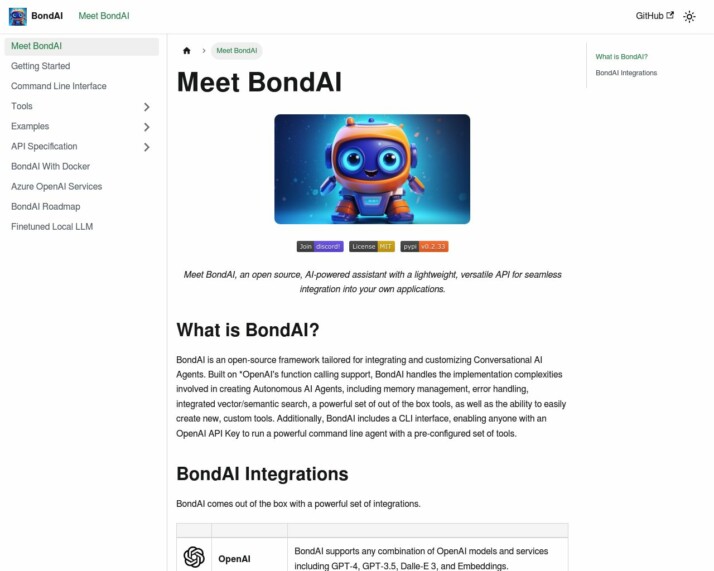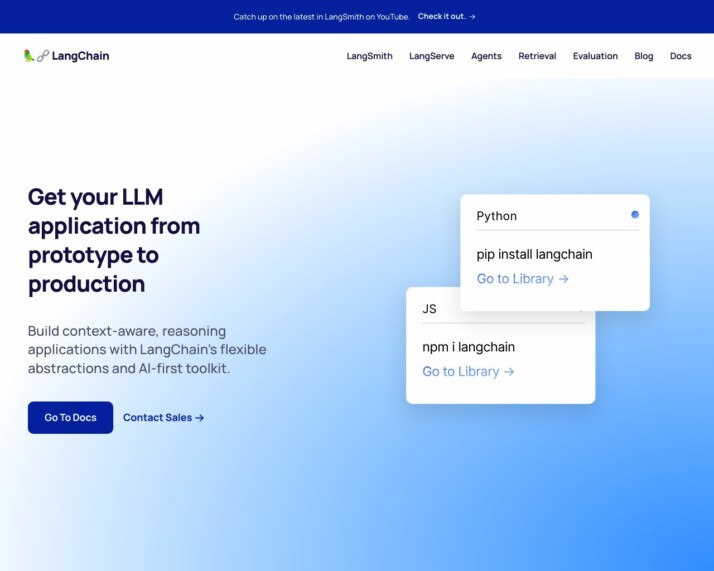Introduction
Are you looking to integrate and customize Conversational AI Agents? If so, you’ve come to the right place. In this article, we will compare BondAI and LangChain, two companies that offer comprehensive solutions in the field of AI. By analyzing their offerings, target audience, special features, and vision, we will help you understand which option suits your needs better.
BondAI caters to a range of users with its flexible framework, comprehensive API, and array of tools. Developers and engineers will find the framework particularly geared towards their needs, as it offers the ability to create custom AI-driven applications with ease of integration with OpenAI’s models and services.
Businesses and enterprises seeking to enhance customer interactions, automate processes, or integrate AI into existing systems will also find BondAI’s offerings useful. The framework’s scalability and integration with cloud services make it suitable for businesses of various sizes, especially those requiring robust AI solutions.
Innovators in Conversational AI, such as companies and individuals focused on building conversational agents like chatbots or personal assistants, are another key audience for BondAI. The framework’s emphasis on easing the creation and customization of these agents aligns well with the needs of this group. Additionally, for tech-enabled service providers in sectors like finance or healthcare, BondAI provides tools and integrations that can enhance their offerings and operations.
On the other hand, LangChain offers a no-code platform focused on building AI agents with an emphasis on ease of use and versatility. Its unique offerings include a Docker container for security, highlighting a focus on security and safe operation. LangChain is well-suited for a diverse range of applications, offering solutions for retrieval-augmented generation, analyzing structured data, and building chatbots. Its modular design, composable tools, and easy customization make it accessible for developers to either use existing chains or build new ones based on specific requirements.
Ultimately, BondAI and LangChain have different approaches to AI agent development. BondAI aims to provide a comprehensive framework with a robust toolset, making it suitable for technically adept audiences looking to harness the power of AI for creating sophisticated conversational agents and integrating AI into various applications and services. On the other hand, LangChain focuses on simplifying the development of generative AI and NLP applications through its modular design and context-aware application development.
Whether you are a developer, a business looking to enhance customer interactions, or an innovator in conversational AI, this article will provide you with valuable insights into the offerings, features, and target audience of BondAI and LangChain, helping you make an informed decision for your AI integration needs.
Overview of BondAI – Revolutionizing Artificial Intelligence in Finance
Welcome to the world of BondAI, a leader in the field of artificial intelligence in finance. BondAI is a game-changer, providing advanced solutions for those in need of unique, innovative AI applications.


Who is it for, you ask? BondAI’s offerings are perfect for a wide range of users, including developers, engineers, businesses, tech-enabled service providers, and innovators in Conversational AI. It offers tools and features that make building and integrating AI more accessible, efficient, and secure.
It’s not just what they offer now that’s exciting. BondAI is always looking towards the future. Their recent product releases have introduced a host of new tools and features, making AI application development even easier and more efficient.
- The framework’s flexibility, comprehensive API, and tools are a hit with developers and engineers looking to create custom AI-driven applications.
- Businesses and Enterprises find BondAI’s offerings particularly useful for enhancing customer interaction and automating processes.
- The emphasis on ease of creation and customization of conversational agents has made BondAI a favorite among innovators in Conversational AI.
- Service providers in industries like finance and healthcare have benefited from BondAI’s tools and integrations, which have enhanced their offerings and streamlined operations.
So why is BondAI special? It’s all about customization, integration, scalability, and a robust toolset. With features like OpenAI Function Calling Support and a focus on security with a Docker Container option, BondAI stands out from the crowd.
And let’s not forget about BondAI’s vision: a future where AI integration and agent development are not only more accessible and efficient but also scalable and versatile. This vision is what guides BondAI’s continuous innovation and product releases.
In conclusion, whether you’re aiming to innovate or simply improve efficiency in your business, BondAI, with its unique AI solutions in the world of finance, is worth exploring.
Overview of LangChain – Empowering Multilingual Communication
Launched as an open-source project in 2022 by co-founders Harrison Chase and Ankush Gola, LangChain is designed to simplify the process of creating AI applications, particularly in the realm of natural language processing (NLP).


This framework caters mainly to software developers, software engineers, and data scientists experienced in programming languages like Python, JavaScript, or TypeScript.
With its modular design and versatile libraries, LangChain enables support for retrieval-augmented generation, structured data analysis, and chatbot building. This context-aware application development framework has been used to create numerous innovative NLP applications.
LangChain aims to bridge powerful large language models (LLMs) with external data sources, simplifying the development of NLP applications. Key features unique to this system include data connection and retrieval and composable tools for model interaction. Despite not providing a cloud hosting option or SaaS offering for its agents, LangChain allows developers to build simple or optimized chains based on their specific needs.
LangChain supports memory capabilities, allowing AI agents to remember past interactions and use this context in ongoing processes. It also provides debugging capabilities to help understand agent behavior as well as detailed records of AI operations for review and analysis.
Ultimately, LangChain’s ambitions extend beyond multilingual communication. The company’s vision is to streamline AI application development and make it more efficient and accessible for developers. They aim to support organized data volumes for easy access, making them crucial for advanced NLP applications. This could eventually help LangChain transform an industry that so heavily relies on comprehensive and effective communication between different languages.
Comparing Features of LangChain, BondAI, and SmythOS
LangChain and BondAI are powerful Large Language Model (LLM) tools, each with its unique set of capabilities. This comparison will help you understand their respective strengths and guide you in making an informed decision for your LLM needs.
| Features | BondAI | LangChain | SmythOS |
|---|---|---|---|
| Hosted Agents (Dev, Production) | ❌ | ❌ | ✅ |
| Environments (Dev, Production) | ✅ | ❌ | ✅ |
| Visual Builder | ❌ | ❌ | ✅ |
| No-Code Editor | ❌ | ❌ | ✅ |
| Memory & Context | ✅ | ✅ | ✅ |
| Autonomous Agents | ✅ | ❌ | ✅ |
| Explainability and Transparency | ❌ | ✅ | ✅ |
| Debug Mode | ❌ | ✅ | ✅ |
| Multimodal | ❌ | ❌ | ✅ |
| Problem-Solving Capabilities | ✅ | ✅ | ✅ |
LangChain boasts robust capabilities in Debug Mode, Explainability and Transparency, offering users a higher level of control and clarity. Nonetheless, BondAI stands out with its Autonomous Agents feature, allowing for more automated operations. Both platforms offer Memory & Context and Problem-Solving Capabilities, essential for advanced LLM tasks. SmythOS, on the other hand, provides all the mentioned features, making it a comprehensive option for users of all needs.
Explore more about BondAI features and LangChain features to get a deeper understanding of these platforms. This comparison of BondAI features, LangChain features, and SmythOS features aims to give you a clearer understanding for your LLM requirements.
BondAI and LangChain: Audience Analysis
This section aims to identify and describe the profiles of potential readers interested in the comparison between BondAI and LangChain.
The audience for this comparison includes individuals who are looking to explore the features and capabilities of BondAI and LangChain for their AI-driven projects. It is tailored towards professionals in software development, engineering, and data science, particularly those focused on AI. The comparison will be useful for:
- Developers and Engineers: Individuals working on building AI applications would be interested in both BondAI and LangChain. BondAI offers a comprehensive set of tools and APIs that are particularly geared towards developers who want to create custom AI-driven applications. LangChain, on the other hand, might appeal to those interested in language modelling and natural language processing, as it offers various features and tools in this domain.
- Businesses and Enterprises: Both BondAI and LangChain provide solutions that can be beneficial for businesses of all sizes. Businesses looking for AI solutions to improve customer interaction or automate processes would find BondAI’s offerings useful. Meanwhile, companies that rely heavily on language understanding and processing, like customer support or content creation businesses, might find LangChain to be more suitable.
- AI Enthusiasts and Researchers: People who are interested in AI, machine learning, and data science, especially those who are active in research, would find a comparison between BondAI and LangChain intriguing. Both platforms offer unique takes on AI application, and comparing their features, capabilities, and use cases could offer valuable insights for these individuals.
In conclusion, the comparison between BondAI and LangChain would be of interest to a wide array of readers, from developers and businesses to AI enthusiasts and researchers. Both platforms have diverse features that cater to different needs, making this comparison all the more pertinent.
Conclusion
After a thorough comparison between BondAI and LangChain, it is evident that both platforms have their strengths and weaknesses when it comes to building AI chatbots. Let’s summarize the key points:
BondAI:
- BondAI offers a comprehensive API and a wide range of tools, making it attractive for developers looking to create custom AI-driven applications.
- Businesses and enterprises can benefit from BondAI’s scalability and integration with cloud services, allowing them to enhance customer interactions and automate processes.
- BondAI focuses on making the creation and customization of conversational agents more accessible to innovators in the field.
- Tech-enabled service providers in sectors like finance and healthcare can leverage BondAI’s tools and integrations to enhance their offerings and operations.
- However, BondAI lacks the transparency and explainability features that allow users to understand the decision-making processes of its AI agents.
- Additionally, BondAI does not explicitly support multimodal capabilities, limiting its ability to handle different data types like images and audio in a fully connected manner.
LangChain:
- LangChain showcases its wide application range and modular design, providing versatile libraries for AI development needs.
- This platform streamlines the process of creating generative AI applications, particularly in natural language processing (NLP) applications.
- LangChain’s innovative modules ensure effective NLP applications by promoting smooth operation and integration of multiple components.
- With a vision focused on simplifying and enhancing the creation of generative AI and NLP applications, LangChain appeals to professionals in software development, engineering, and data science.
- LangChain also supports memory and context capabilities, enabling AI agents to remember past interactions and use context in ongoing processes.
- However, LangChain lacks autonomous agents with self-improvement mechanisms and does not offer detailed audit logs for analytics purposes.
Considering all factors, it is clear that SmythOS outshines both BondAI and LangChain in terms of its features and benefits. SmythOS offers a user-friendly platform with superior customization options, explainability, and transparency features. Furthermore, SmythOS supports multimodal capabilities, allowing for the integration of various data types, and provides comprehensive audit logs for analytics purposes.
In conclusion, while both BondAI and LangChain have their merits, SmythOS is the preferred choice for those seeking to harness the power of AI in creating sophisticated conversational agents and integrating AI into various applications and services. Its ease of use, scalability, and robust toolset make it the ideal platform for innovation and efficiency through AI.
Last updated:
Disclaimer: The information presented in this article is for general informational purposes only and is provided as is. While we strive to keep the content up-to-date and accurate, we make no representations or warranties of any kind, express or implied, about the completeness, accuracy, reliability, suitability, or availability of the information contained in this article.
Any reliance you place on such information is strictly at your own risk. We reserve the right to make additions, deletions, or modifications to the contents of this article at any time without prior notice.
In no event will we be liable for any loss or damage including without limitation, indirect or consequential loss or damage, or any loss or damage whatsoever arising from loss of data, profits, or any other loss not specified herein arising out of, or in connection with, the use of this article.
Despite our best efforts, this article may contain oversights, errors, or omissions. If you notice any inaccuracies or have concerns about the content, please report them through our content feedback form. Your input helps us maintain the quality and reliability of our information.
Alexander De Ridder
Co-Founder, Visionary, and CTO at SmythOS. Alexander crafts AI tools and solutions for enterprises and the web. He is a smart creative, a builder of amazing things. He loves to study “how” and “why” humans and AI make decisions.
Explore All Comparison Articles
Decisions vs. Sola: AI Workflow Automation Showdown
AI-powered workflow automation platforms revolutionize how businesses streamline operations and boost productivity. This comparison explores Decisions vs. Sola, and SmythOS,…
DeepOpinion vs. Sola: Comparing AI Automation Platforms
AI-powered automation platforms revolutionize business operations, but choosing the right solution can be challenging. This comparison of DeepOpinion vs. Sola,…
DevGPT vs. Sola: AI-Powered Development Tools Compared
AI-powered development tools revolutionize software creation, offering unprecedented efficiency and capabilities. This comprehensive review compares DevGPT vs. Sola, and SmythOS,…
Fine AI vs. Sola: Comparing AI Automation Tools
AI-powered automation transforms software development and business workflows, offering unprecedented efficiency and innovation. Fine AI vs. Sola present distinct approaches…
FlowiseAI vs. Sola: Comparing AI Automation Platforms
AI-powered automation revolutionizes business operations, driving efficiency and innovation across industries. FlowiseAI vs. Sola offer distinct approaches to harness this…
Gooey AI vs. Sola: AI-Powered Automation Platforms Compared
AI-powered automation platforms revolutionize how businesses streamline operations and enhance productivity. This comparison delves into Gooey AI vs. Sola, two…

